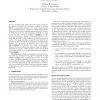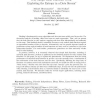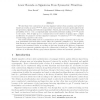8 search results - page 1 / 2 » Tight Bounds for Hashing Block Sources |
APPROX
2008
Springer
13 years 6 months ago
2008
Springer
It is known that if a 2-universal hash function H is applied to elements of a block source (X1, . . . , XT ), where each item Xi has enough min-entropy conditioned on the previous...
SPAA
1993
ACM
13 years 9 months ago
1993
ACM
d Abstract) Thomas H. Cormen Leonard F. Wisniewski Department of Mathematics and Computer Science Dartmouth College We give asymptotically equal lower and upper bounds for the num...
SODA
2008
ACM
13 years 6 months ago
2008
ACM
Hashing is fundamental to many algorithms and data structures widely used in practice. For theoretical analysis of hashing, there have been two main approaches. First, one can ass...
FOCS
2007
IEEE
13 years 11 months ago
2007
IEEE
We show that every construction of one-time signature schemes from a random oracle achieves black-box security at most 2(1+o(1))q , where q is the total number of oracle queries a...
INFOCOM
2009
IEEE
13 years 11 months ago
2009
IEEE
—The performance of randomized network coding can suffer significantly when malicious nodes corrupt the content of the exchanged blocks. Previous work have introduced error corr...



